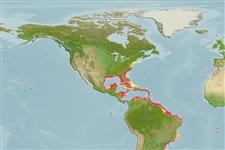Environment: milieu / climate zone / depth range / distribution range
Ecología
marino asociado a arrecife; rango de profundidad 1 - 70 m (Ref. 126840), usually 5 - 55 m (Ref. 5288). Subtropical; 43°N - 30°S, 98°W - 5°W
Western Atlantic: Bermuda, Massachusetts, and northern Gulf of Mexico to southern Brazil. Eastern Atlantic: Ascension and St. Helena.
Tamaño / Peso / Age
Maturity: Lm ? range ? - ? cm
Max length : 45.0 cm TL macho / no sexado; (Ref. 5288); common length : 30.0 cm TL macho / no sexado; (Ref. 3812); peso máximo publicado: 1.6 kg (Ref. 40637)
Espinas dorsales (total) : 12; Radios blandos dorsales (total) : 10; Espinas anales: 3; Radios blandos anales: 5. Occipital pit present; three to four spines on part of preorbital overlapping maxillary; large white spots on dark background on inner basal part of pectoral fin (unclear in specimens smaller than 3 cm SL) (Ref. 13608).
Found mostly in shallow coral reef and rocky areas. Lies motionless on the bottom (Ref. 9710). Feeds mostly on other fishes and crustaceans. Moderately common below about 5 m depth to at least 55 m. Displays characteristic bright white spots on dark background of pectoral axil when disturbed (Ref. 49392). Anterolateral glandular groove with venom gland (Ref. 57406). Eaten locally and said to taste a bit like chicken. Traded as an aquarium fish at Ceará, Brazil (Ref. 49392).
Life cycle and mating behavior
Maturities | Reproducción | Spawnings | Egg(s) | Fecundities | Larva
Smith-Vaniz, W.F., B.B. Collette and B.E. Luckhurst, 1999. Fishes of Bermuda: history, zoogeography, annotated checklist, and identification keys. American Society of Ichthyologists and Herpetologists Special Publication No. 4. 424 p. (Ref. 35505)
IUCN Red List Status (Ref. 130435)
Human uses
Pesquerías: escaso valor comercial; Acuario: Comercial
Herramientas
Special reports
Download XML
Fuentes de Internet
Estimates based on models
Preferred temperature (Ref.
123201): 21.9 - 28, mean 25.6 °C (based on 770 cells).
Phylogenetic diversity index (Ref.
82804): PD
50 = 0.5000 [Uniqueness, from 0.5 = low to 2.0 = high].
Bayesian length-weight: a=0.01514 (0.00987 - 0.02321), b=3.00 (2.87 - 3.13), in cm total length, based on LWR estimates for this species & Genus-body shape (Ref.
93245).
Nivel trófico (Ref.
69278): 3.6 ±0.3 se; based on diet studies.
Resiliencia (Ref.
120179): Bajo, población duplicada en un tiempo mínimo de 4.5-14 años (Preliminary K or Fecundity.).
Fishing Vulnerability (Ref.
59153): Low to moderate vulnerability (35 of 100).
Nutrients (Ref.
124155): Calcium = 26.5 [10.7, 67.5] mg/100g; Iron = 0.53 [0.27, 1.47] mg/100g; Protein = 19.3 [17.6, 21.0] %; Omega3 = 0.293 [0.127, 0.806] g/100g; Selenium = 16.8 [7.9, 40.6] μg/100g; VitaminA = 58.3 [19.9, 179.9] μg/100g; Zinc = 0.815 [0.541, 1.238] mg/100g (wet weight);
